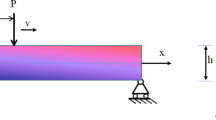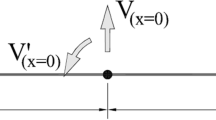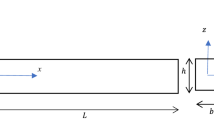Abstract
The postbuckling analysis of a modified nonlinear beam composed of axial functionally graded material (FGM) is investigated by a canonical dual finite element method (CD-FEM). The governing equation of the axial FGM nonlinear beam is derived through a variational method. The CD-FEM is adopted to find the nonconvex postbuckling configurations of the beam according to Gao’s triality theory. Using duality transition, the original potential energy functional becomes a functional of deformation and dual stress fields. By variation of the mixed complementary energy, the coupling equations are derived to find deformation and dual stress fields. In FEM, matrices of a beam element depend on the gradient of material property (elastic modulus). To obtain general forms of matrices of a beam element, the graded elastic modulus is approximated by piecewise linear functions with respect to axial position. Numerical examples are presented to show the effects of graded elasticity on the postbuckling configurations of the beam.


















Similar content being viewed by others
References
Suresh S, Mortensen A (1988) Fundamentals of functionally graded materials. IOM Communications, London
Jha DK, Kant T, Singh RK (2013) A critical review of recent research on functionally graded plates. Compos Struct 96:833–849
Wang H, Qin QH, Kang YL (2006) A meshless model for transient heat conduction in functionally graded materials. Comput Mech 38:51–60
Wang H, Qin QH (2008) Meshless approach for thermo-mechanical analysis of functionally graded materials. Eng Anal Boundary Elements 32:704–712
Wang H, Qin QH (2012) Boundary integral based graded element for elastic analysis of 2d functionally graded plates. Eur J Mech A Solids 33:12–23
Eltaher MA, Emam SA, Mahmoud FF (2013) Static and stability analysis of nonlocal functionally graded nanobeams. Compos Struct 96:82–88
Chakraborty A, Gopalakrishnan S (2003) A spectrally formulated finite element for wave propagation analysis in functionally graded beams. Int J Solids Struct 40:2421–2448
Yang J, Chen Y (2008) Free vibration and buckling analyses of functionally graded beams with edge cracks. Compos Struct 83:48–60
Simsek M (2010) Vibration analysis of a functionally graded beam under a moving mass by using different beam theories. Compos Struct 92:904–917
Huang Y, Li X-F (2010) A new approach for free vibration of axially functionally graded beams with non-uniform cross-section. J Sound Vib 329:2291–2303
Reddy JN (2011) Microstructure-dependent couple stress theories of functionally graded beams. J Mech Phys Solids 59:2382–2399
Ke L-L, Yang J, Kitipornchai S (2009) Postbuckling analysis of edge cracked functionally graded timoshenko beams under end shortening. Compos Struct 90:152–160
Singh KV, Li G (2009) Buckling of functionally graded and elastically restrained non-uniform columns. Compos Part B Eng 40:393–403
Benatta MA, Tounsi A, Mechab I, Bouiadjra MB (2009) Mathematical solution for bending of short hybrid composite beams with variable fibers spacing. Appl Math Comput 212:337–348
Sharifishourabi G, Alebrahim R, Teshnizi SHS, Ani FN (2012) Effects of material gradation on thermo-mechanical stresses in functionally graded beams. In: Dan Y (ed) 2nd international conference on chemistry and chemical process, pp. 194–199
Murin J, Aminbaghai M, Hrabovsky J, Kutis V, Kugler S (2013) Modal analysis of the fgm beams with effect of the shear correction function. Compos Part B Eng 45:1575–1582
Shahba A, Attarnejad R, Hajilar S (2011) Free vibration and stability of axially functionally graded tapered Euler–Bernoulli beams. Shock Vib 18:683–696
Gao DY (1996) Nonlinear elastic beam theory with application in contact problems and variational approaches. Mech Res Commun 23:11–17
Gao DY (2000) Duality principles in nonconvex systems: theory, methods and applications. Kluwer Academic Publishers, Dordrecht
Kuttler KL, Purcell J, Shillor M (2012) Analysis and simulations of a contact problem for a nonlinear dynamic beam with a crack. Q J Mech Appl Math 65:1–25
Lu CF, Chen WQ, Xu RQ, Lim CW (2008) Semi-analytical elasticity solutions for bi-directional functionally graded beams. Int J Solids Struct 45:258–275
Levinson M (1965) Complementary energy theorem in finite elasticity. J Appl Mech 32:826–828
Qin QH (1995) Geometrically nonlinear analysis of shells by the variational approach and an efficient finite element formulation. Comput Struct 55:727–733
Qin QH (1995) Postbuckling analysis of thin plates by a hybrid trefftz finite element method. Comput Methods Appl Mech Eng 128:123–136
Gao Y, Strang G (1989) Geometric nonlinearity: potential-energy, complementary energy, and the gap function. Q Appl Math 47:487–504
Gao DY (1999) Pure complementary energy principle and triality theory in finite elasticity. Mech Res Commun 26:31–37
Gao DY (1999) General analytic solutions and complementary variational principles for large deformation nonsmooth mechanics. Meccanica 34:169–198
Li SF, Gupta A (2006) On dual configurational forces. J Elast 84:13–31
Pian THH (1964) Derivation of element stiffness matrices by assumed stress distributions. AIAA J 2:1333–1336
Hodge PG, Belytsch T (1968) Numerical methods for limit analysis plates. J Appl Mech 35:796–801
Qin QH (2000) The trefftz finite and boundary element method. WIT Press, Southampton
Qin QH (2003) Variational formulations for TFEM of piezoelectricity. Int J Solids Struct 40:6335–6346
Qin QH, Wang H (2008) Matlab and C programming for trefftz finite element methods. Taylor and Francis, Boca Raton
Jirousek J, Wroblewski A, Qin QH, He XQ (1995) A family of quadrilateral hybrid Trefftz p-element for thick plate analysis. Comput Methods Appl Mech Eng 127:315–344
Gao DY, Wu C (2012) On the triality theory for a quartic polynomial optimization problem. J Ind Manag Optim 8:229–242
Acknowledgments
The financial support of the US Air Force Office of Scientific Research (Grant No. FA9550-10-1-0487), the National Natural Science Foundation of China (Grant No. 50908190), the Youth Talents Foundation of Shaanxi Province (Grant No. 2011kjxx02), and the Research Foundation (GZ1205) of the State Key Laboratory of Structural Analysis for Industrial Equipment, Dalian University of Technology, Dalian, China, is fully acknowledged.
Author information
Authors and Affiliations
Corresponding author
Rights and permissions
About this article
Cite this article
Cai, K., Gao, D.Y. & Qin, Q.H. Postbuckling analysis of a nonlinear beam with axial functionally graded material. J Eng Math 88, 121–136 (2014). https://doi.org/10.1007/s10665-013-9682-1
Received:
Accepted:
Published:
Issue Date:
DOI: https://doi.org/10.1007/s10665-013-9682-1




